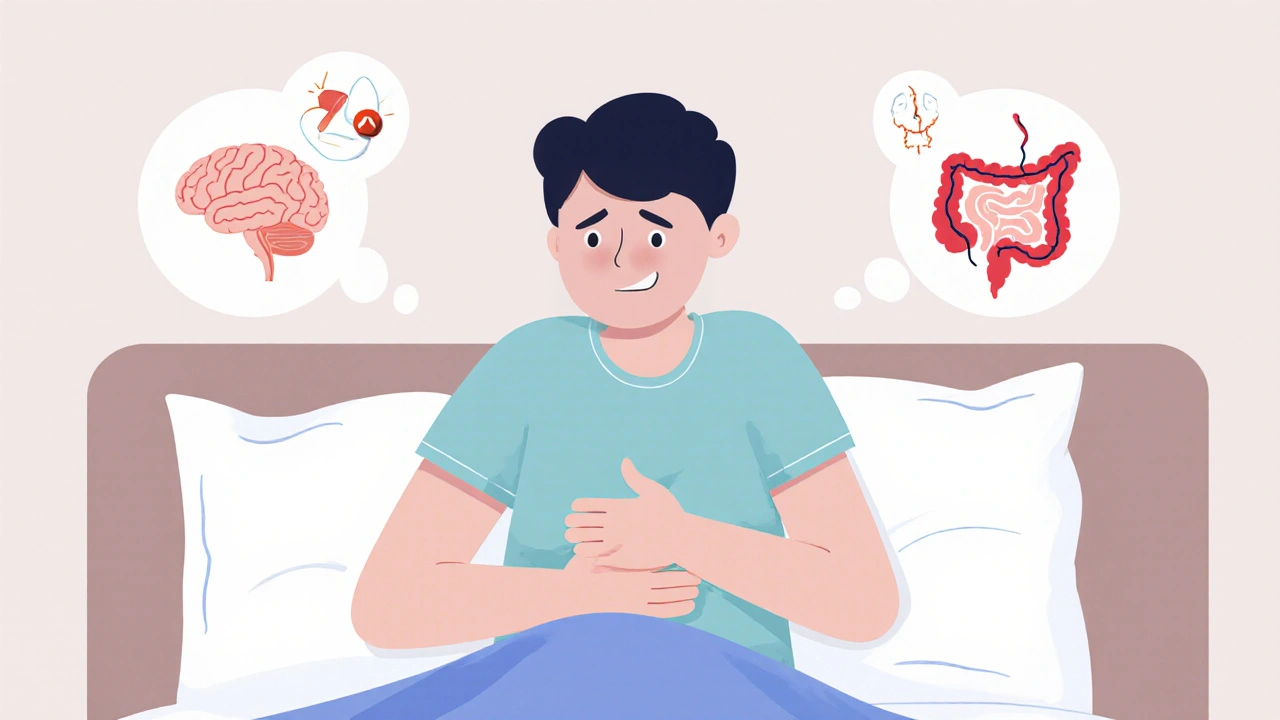
Opioid Nausea Symptom Checker
Identify Your Nausea Type
Select the primary cause of your nausea:
Important Contraindications
When someone starts taking opioids for pain, they often don’t expect to feel sick. But opioid-induced nausea and vomiting (OINV) is one of the most common side effects - affecting between 20% and 33% of patients, according to studies from 2012. It’s not just unpleasant; it’s a major reason people stop taking their pain medication. In fact, research shows many patients would rather endure more pain than deal with persistent nausea. That’s why managing this side effect isn’t just about comfort - it’s about making sure pain treatment actually works.
Why Do Opioids Make You Nauseous?
Opioids don’t just block pain signals. They also trigger a chain reaction in your body that leads to nausea and vomiting. One key mechanism is how they slow down your gut. When opioids bind to receptors in your intestines, they reduce movement, which can cause bloating and discomfort that your brain interprets as nausea. But it’s not just your stomach. Opioids also stimulate the chemoreceptor trigger zone - a small area in your brainstem that acts like a nausea alarm. This zone is packed with dopamine receptors, and opioids activate them directly.
Another factor is your inner ear. Opioids can increase sensitivity in the vestibular system, making you feel dizzy or off-balance, especially when you move. That’s why some patients feel nauseous just standing up or turning their head. These multiple pathways mean there’s no single fix. What works for one person might do nothing for another.
Common Antiemetics Used - and Their Risks
Doctors often reach for antiemetics to help, but not all are created equal. The most common ones include ondansetron, metoclopramide, droperidol, and palonosetron. Each has different strengths and dangers.
Ondansetron (Zofran) blocks serotonin in the gut and brain. Studies show 8 mg and 16 mg doses are effective for treating established nausea from opioids. But it comes with a serious warning: the FDA has flagged it for causing prolonged QTc intervals, which can lead to dangerous heart rhythms. The same goes for droperidol - even though it’s cheap and effective, it carries a black box warning for cardiac risks.
Palonosetron, a newer option, performed better than ondansetron in one study, reducing nausea from 62% to 42%. But it’s more expensive and not always covered by insurance. Then there’s metoclopramide - long used as a go-to, but recent evidence shows it doesn’t reliably prevent nausea when given before opioids. A 2022 Cochrane review analyzed three small trials and found no meaningful benefit from prophylactic metoclopramide. It also carries risks like muscle spasms and restlessness, especially in older adults.
For nausea tied to dizziness or movement, drugs like scopolamine patches or meclizine can help by targeting the inner ear. These are often overlooked but can be lifesavers for patients who feel sick when they walk or turn over in bed.
Prophylaxis vs. Reactive Treatment - What Works?
Should you give antiemetics before the nausea starts, or wait until it hits? The answer isn’t one-size-fits-all.
Most experts now agree: routine prophylaxis isn’t necessary for everyone. A 2013 review found that giving antiemetics upfront to all opioid-naïve patients doesn’t improve outcomes enough to justify the cost or risk. Instead, the best approach is to wait and watch. About 80% of patients develop tolerance to nausea within 3 to 7 days at a steady opioid dose. That means for many, the problem resolves on its own.
So the smarter strategy is reactive treatment. If nausea appears, then pick the antiemetic based on the likely cause:
- If it’s gut-related (bloating, no dizziness) → try a serotonin blocker like ondansetron
- If it’s motion-triggered (dizziness, turning head) → use scopolamine or meclizine
- If it’s severe and unresponsive → consider an antipsychotic like haloperidol
This targeted approach reduces unnecessary drug exposure and avoids side effects from medications that aren’t needed.

Drug Interactions That Can Be Deadly
One of the biggest dangers isn’t just the antiemetic itself - it’s what it’s mixed with. Opioids can interact dangerously with other common medications.
Combining opioids with certain antidepressants - especially SSRIs like sertraline or SNRIs like venlafaxine - can trigger serotonin syndrome. This is a life-threatening condition marked by high fever, rapid heart rate, muscle rigidity, and confusion. The FDA has required updated warnings on opioid labels because of this risk.
Even migraine meds like triptans can add to the danger. And mixing opioids with benzodiazepines (like Xanax or Valium) or alcohol can slow breathing to a fatal level. These combinations are more common than you think. Many patients take multiple prescriptions without realizing how they interact.
Always check for interactions before starting any new drug. A simple pharmacy review can catch these before they cause harm.
Non-Drug Strategies That Actually Work
Before reaching for another pill, try these evidence-based approaches:
- Start low, go slow. The CDC recommends beginning with the lowest effective opioid dose and increasing gradually. A dose of 1 mg of morphine twice daily for chronic breathlessness, for example, is often enough and causes fewer side effects.
- Switch opioids. Not all opioids cause the same level of nausea. Tapentadol, for instance, has about 3-4 times lower nausea risk per dose than oxycodone. Oxymorphone, on the other hand, is much worse - nearly 60 times higher risk per exposure. If nausea hits hard, switching to a different opioid can make a big difference.
- Reduce the dose. Sometimes, lowering the opioid dose slightly doesn’t hurt pain control but cuts nausea dramatically. Pain isn’t always all-or-nothing; small reductions can still offer relief while improving tolerance.
- Hydrate and move gently. Dehydration worsens nausea. Sipping water and walking short distances can help reset your gut and balance system. Even light activity can reduce the dizziness that triggers vomiting.
What the Guidelines Say
The 2022 CDC Clinical Practice Guideline for Prescribing Opioids is clear: providers must tell patients about common side effects - including nausea and vomiting - before starting treatment. This isn’t just good practice; it’s a standard of care. Patients who know what to expect are less likely to stop their medication out of fear.
Guidelines also stress that opioids are meant for short-term use - like after surgery or injury - not for long-term chronic pain. The opioid epidemic has shown us that prolonged use increases risks without necessarily improving quality of life. When possible, non-opioid options like physical therapy, nerve blocks, or certain antidepressants should be tried first.
When to Call for Help
Not all nausea is harmless. Seek medical attention if you experience:
- Severe dizziness or fainting
- Irregular heartbeat or chest pain
- High fever, stiff muscles, or confusion
- Difficulty breathing or extreme drowsiness
These could signal serotonin syndrome, cardiac issues, or respiratory depression - all medical emergencies. Never ignore new or worsening symptoms after starting a new opioid or antiemetic.
Final Takeaways
Managing opioid-induced nausea isn’t about throwing drugs at the problem. It’s about understanding why it happens, matching treatment to the cause, and avoiding dangerous combinations. Most patients will outgrow the nausea within a week. For those who don’t, targeted, low-dose antiemetics - chosen based on symptoms - work better than blanket prescriptions.
The goal isn’t to eliminate every bit of nausea. It’s to keep patients on their pain medication safely, without adding new risks. That means listening to the patient, watching for red flags, and choosing the least invasive solution first. Sometimes, the best medicine is time - and patience.





